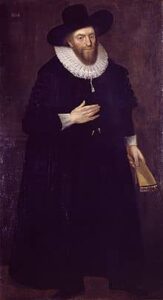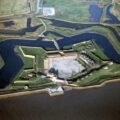
On this day in history, the 19th February 1592, the Rose Theatre, an Elizabethan play house, was opened in London on Bankside.
In 1585 Philip Henslowe, a London businessman and property developer, leased a tenement and gardens known as the Little Rose. In 1587, with the help of grocer John Cholmley and carpenter John Griggs, Henslowe built the Rose Theatre which opened in 1592. The Rose Theatre website tells of how not much is known about the theatre between 1587 and 1592, but we have records from 1592 when Henslowe started to keep an account book, “Henslowe’s Diary”. In that same year, Henslowe’s step-daughter married Edward Alleyn, a well-known actor, who moved his group of actors made up from the Admiral’s Men and Lord Strange’s Men acting groups to the Rose Theatre. The theatre was then enlarged for this troupe of actors and the extra spectators who would come to see them.
“Henslowe’s Diary” and Edward Alleyn’s papers from the College of God’s Gift (Dulwich College), which he founded in 1619 records not only the expenditure involved in extending the Rose Theatre and its upkeep, but also the plays that were staged there, the number of spectators and also the props and costumes used. From these records, we know that the Rose Theatre’s repertory included Shakespeare’s Henry VI Part 1 and Titus Andronicus, Kyd’s Spanish Tragedy, and Marlowe’s Doctor Faustus, Jew of Malta and Tamburlaine the Great.
In 1594-1596 the Swan Theatre was built, followed by the Globe Theatre in 1599, and these rival theatres adversely affected the popularity of the Rose. When in June 1600 the Privy Council decreed that only two theatres would be allowed to stage plays – the Globe Theatre and the Fortune Theatre (also built by Henslowe and Alleyn) – the Rose Theatre began its decline and was abandoned by 1605, if not earlier.
In 1988 the demolition of a 1950s office block meant that the site of the Rose Theatre could be investigated and in 1989 a campaign to “Save the Rose” was launched by Lord Olivier (actor Laurence Olivier). In May 1989 archaeologists from the Museum of London were successful in uncovering two thirds of the Rose Theatre’s ground plan. As well as giving vital information on how the Rose Theatre was built and how it would have looked, the site gave up over 700 precious Elizabethan artifacts: coins, fragments of the money boxes used to collect entrance money, tokens, hazelnut shells from the nuts eaten by the Elizabethan audiences, and jewellery. The articles found are now kept at the Museum of London.
The site was opened to the public in 1999 but work is still continuing and English Heritage are seeking to enlarge the perimeter of the site so that further excavations can be done. Two thirds of the original Rose Theatre’s foundations have been excavated and protected, and the Rose Theatre Trust is now busy fundraising so that the remaining third can be excavated so that the Rose Theatre site can be a permanent display to educate visitors about the past.
You can find out more about the Rose Theatre and the Rose Theatre Trust at www.rosetheatre.org.uk.
You can see a model of the Rose Theatre at theMuseum of London website and a picture of a Shakespearian shoes found at the site at http://www.museumoflondonarchaeology.org.uk/English/News/Current/Shakesperianshoes.htm





